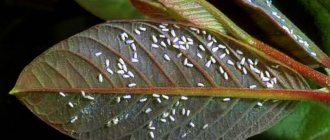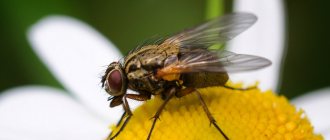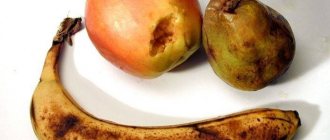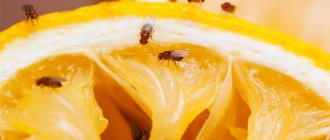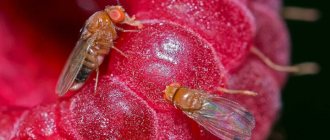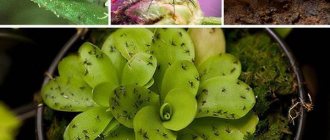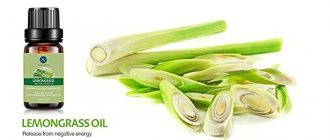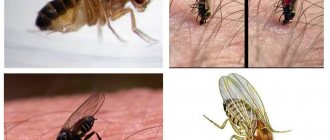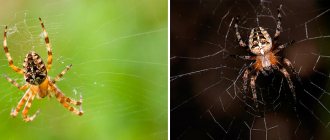Good afternoon, dear guests of the site “I am a villager”!
Today we’ll talk about the annoying midge and the current means of protection against this little fly. In the last article we learned about means and methods of protection against mosquitoes. The midge turned out to be more annoying and the methods that work on mosquitoes don’t really scare it. There are about 1,800 species of midges in the world; their lifespan is 1 month. Over the summer they can give birth to 4 offspring and lay eggs in the fall so that annoying midges appear in early spring. Midges live and breed near ponds and rivers. If your house or cottage is located near a body of water, you need to prepare in advance to meet these annoying bloodsuckers.
Types of midges
Midge is a collective name for many thousands of species of insects that look somewhat similar to ordinary flies, but are smaller in size.
Most of them are representatives of the order Diptera, but the damage they cause, their habitat, and their lifestyle patterns can differ significantly.
Typically, the term “midge” includes several types of pests:
- Nasty . Small blood-sucking insects that swarm in the air, bite humans and pets, and drink blood. These midges, unlike mosquitoes, do not just pierce the skin, but tear off the top layer so that a tiny drop of blood appears on the surface. This is what the insect drinks. The saliva of midges contains special substances that have an analgesic and anticoagulant effect - so a person for the time being does not feel that he has been bitten. After the bite, the effect of the substances wears off and the affected area begins to itch. The cause of itching is foreign proteins that cause rejection, entering the blood along with the insect's saliva. Swarms of midges can ruin any country holiday.
- Fruit midges . The most famous is the Drosophila, used by scientists in genetic experiments. This species of small insect is extremely prolific. If you leave slightly spoiled fruit in the trash or even on the table, a huge number of fruit flies will immediately breed there. They feed on plant juices and pose no harm to humans, but their abundance annoys their careful owner.
- Plant pests . These small midges multiply on the above-ground parts of wild and cultivated plants, leading to damage to the marketable appearance, deterioration of the condition of the crop, up to its complete damage. The fight against such varieties is necessary if a summer resident cares about the harvest and plants that grow on his site.
The benefits of using folk remedies against midges
These small pests can be much more annoying than flies and mosquitoes; they circle in the air in swarms, get into your eyes, and also bite very painfully. Moreover, the midge can pester not only on the street, but also penetrate into the house. As it turned out, it is not difficult to protect yourself from mosquitoes and midges; folk remedies will help with this. They do not require large expenses, are easy to prepare and use.
Availability of ingredients
To prepare a folk remedy for midges, you don’t have to look long for suitable ingredients. They can be found in the home medicine cabinet, refrigerator, pharmaceutical department, your own cosmetic bag, or even in the forest or garden.
Safety
Chemicals with an insecticidal effect have some contraindications and possible side effects. For example, for some people, working for a long time with a fumigator causes headaches. At the same time, turning it on for a short time and ventilating the room significantly reduces its effectiveness.
It is difficult for people who are allergic to chemicals. However, homemade mosquito repellents have minimal negative effects. Among the variety of recipes, you can choose a composition without allergens.
Despite their relative safety, homemade products can cause allergies. It is recommended to consult a doctor before using them.
Use for children and pregnant women
Store-bought repellents, with rare exceptions, are contraindicated for pregnant women and children. And those that can be used act for a short time and contain a low dose of the active ingredient.
Among folk recipes there are compositions suitable for protecting children and expectant mothers from midges. For example, for babies under one year old you can use a number of essential oils:
- chamomile;
- pink;
- lavender;
- lemon;
- cinnamon;
- orange;
- sandalwood.
After a year, the use of mint and eucalyptus oils is allowed.
To make a safe midge remedy for a child, it is important to follow the dosage:
- up to 12 months - no more than 1 drop of essential oil added to the base composition;
- from 1 year to 5 years – the dose is increased to 2 drops;
- from 6 to 12 years – half the adult dosage.
Among the safe folk remedies against midges on the street, one can note wearing an aroma pendant:
- It is made from a Kinder egg capsule.
- Holes are drilled in the walls.
- A cotton swab with a couple of drops of essential oils is placed inside to repel insects.
- Holes are made in the capsule through which the lace is threaded. A protection pendant is worn around the neck.
The protective solution can also be applied to the baby’s shoes and clothes, stroller or other vehicle. Scented substances will repel annoying pests.
Control measures
Fighting midges is a whole complex of measures. It includes the use of various natural and synthetic agents to kill and repel, methods of pain relief for received bites, as well as preventive actions to eliminate the causes of these unpleasant insects.
Repellent
Since bloodsuckers are a nuisance mainly in the open air, it is rather pointless to fight them by destroying them. New ones will immediately fly in to replace the dead specimens, since insects are the most numerous living creatures on the planet. It is simply impossible to destroy all swarms of midges in the area of your site - in such a situation, repelling seems to be the most appropriate.
To do this, different means and methods are used:
Vanilla and vanilla
The strong-smelling substance not only masks the odor of the human body - it is strongly distasteful to the blood-sucking vile.
In order to obtain a homemade preparation, vanilla pods are infused with vodka or alcohol, and then rubbed with the resulting composition on bare skin or sprayed from a spray bottle. True, natural vanilla is too expensive - crystalline vanillin is used much more often. It dissolves well in water, costs a penny and is suitable for everyone.
You can use a neutral baby cream as a base. Thanks to this, the product will be applied to the skin evenly, and the scent will last longer.
Essential oils and extracts
Since all these substances are strongly odorous, they help repel pesky bloodsuckers. It is worth applying oily products at those points where they will give the maximum effect: behind the ears, in the neck area, on the wrists and elbows, under the knees and around the ankles. Coniferous extracts, eucalyptus oils, cloves, and anise are best suited.
Branches and leaves of plants
Many crops are natural midge repellents. For example, from the steppe herbs wormwood or wheatgrass, you should take the roots and boil them, and lubricate the exposed areas of the body with the resulting decoction. Scented tomato shoots or elderberry branches will help drive insects out of the room, but also minimize their irritating effect outdoors.
Valerian solution in alcohol
A well-known sedative can be successfully used against midges when sprayed over the surface of the body.
Expert opinion
Mityuk Stefania Bogdanovna
If you are preparing barbecue or grilled dishes at your dacha, you can throw pine branches into the fire. Juniper gives the strongest effect.
Electrical and heating devices
Technological progress has not remained aloof from the fight against flying parasites.
Compact and convenient electrical appliances come to the aid of summer residents. This device is based on a luminous tube that emits rays in ultraviolet light, which attracts insects. The housing in which the lamp is located is covered with a special mesh to which electric current is supplied.
When insects fall on the mesh, they are literally charred, although the voltage and current parameters are absolutely safe for humans and pets.
Hanged near the table at which a picnic is arranged, this device will successfully distract and kill not only midges, but also other unpleasant arthropods. The only drawback is the need for periodic cleaning.
Another direction is fumigators - heating devices that bring a special liquid to a temperature where it begins to emit vapors that kill or drive away annoying insects.
If electricity is not at hand, special spirals are used, which, while smoldering, saturate the air around with volatile compounds. The most famous brands in the market are Mosquitall, Raid, Raptor, Fumitox, Vape and others.
Chemical substances
On sale you can find a variety of products that are intended for treating premises, local areas, and garden plots, helping to destroy midges, their larvae and eggs, and also prevent them from reproducing.
Most often, these ready-made formulations are based on certain active ingredients:
- Diethyltoluamide (DEET) is a composition that has both a repellent (repellent) and insecticidal (destructive) effect. It is used in various forms: ointments, creams, sprays, liquids and much more.
- Cypermethrin - does not penetrate into plants, but remains on treated surfaces for 20 - 30 days (if there is no rain). Destroys many types of harmful insects, including blood-sucking midges, as well as pests such as white and black midges (melons). Available in the form of a concentrate, it is used to treat the entire area using a garden sprayer.
Chemical preparations for midges in the country
Small midges are difficult to remove insects, and it is not always possible to get rid of them after the first attempt. If traditional methods are powerless or you trust store-bought products more, pay attention to chemicals.
- Digital. A product for killing mosquitoes, midges and other flying insects in natural conditions. After treating the area, the pests die. Repeated treatment is recommended no earlier than 6 weeks after the first. The drug is available in the form of a concentrated solution, which must be diluted with water before use.
- Mospilan. Plant treatment product. Destroys adult mosquitoes, eggs and larvae of midges. The effectiveness of the drug is maintained at elevated temperatures. The product must be dissolved in water. The effect is observed within an hour after treatment, and the protective effect lasts about 2-3 weeks.
- Phosbecide. Available in the form of a concentrate. Suitable for both killing household insects and pest control. The effect of the drug is 2-3 weeks. It is not recommended to carry out treatment during the flowering period of plants, in hot weather (at temperatures above 25 degrees), before rain, or when there is dew on the leaves of plants.
Attention! It is recommended to treat the area with chemicals in the early morning or evening in calm weather.
Treating Bites
In most cases, a midge bite is not too dangerous for humans, but it does cause a lot of discomfort. Even in the absence of an allergic reaction, the bite site is very itchy and itchy.
This effect can be reduced using various means:
- A solution of water and regular baking soda in a ratio of 1 teaspoon of sodium bicarbonate per glass of water. Has a calming effect.
- Ammonia. Before use, it must be diluted with water in equal parts.
- “Zvezdochka” balm, known since the times of the USSR. Has a cooling and distracting effect. Thanks to its composition, it can be used not only after a bite, but also to prevent it.
- Dairy products. An ancient folk method to reduce itching. Used chilled.
- Various pharmaceutical preparations, they are also used in cases of hypersensitivity to midge bites.
What kind of midges grow on personal plots?
The term summer midge can hide two types of pests:
- black midge, which summer residents call melon aphids;
- white midge, better known as whitefly.
Representatives of both species are very prolific, harmful, and controlling them can be very difficult.
black midge
This type of pest includes two subspecies of midges: with and without wings. They live mainly in tomato beds, sitting on the bushes in a dense layer. As was already said, such midges reproduce very quickly and also quickly disperse throughout the garden. Damaged bushes wither and die over time.
To prevent black midges from entering the garden, experienced summer residents advise planting plants around the perimeter of tomato beds that will attract its natural enemies: wasps, ladybugs, hoverflies and lacewings. In addition to fragrant herbs, it is advisable to plant dill, garlic, onions and calendula on the site - midges really do not like their aroma, and therefore rarely settle near them. It also wouldn’t hurt to inspect the area and destroy any anthills found on it. This measure is necessary due to the fact that ants feed on the secretion secreted by black flies, and therefore protect them from other insects.
White midge
White midges are found mainly in greenhouses. She settles on the back of the leaves, where she lays her eggs. Over time, larvae emerge from the eggs, which, feeding on plant juices, cause great harm to them.
Determining that a crop is infected is quite simple - all you have to do is pay attention to its appearance. On plants affected by white midges, the leaves begin to curl, the fruits ripen unevenly and many become white inside, a whitish coating is visible on the foliage, which turns black after a while, and despite proper watering, the green parts of the bush gradually turn yellow. In order to make sure that it was the white midge that attacked the plant, you just need to touch it, and the pests on it will immediately fly away.
Important! Bushes affected by whitefly quickly weaken and become vulnerable to pathogens of viral, bacterial and fungal diseases!
Since the white midge loves moisture very much, it rarely appears in the garden. This parasite lives mainly in greenhouses, where conditions that are comfortable for it are always present. And in order to prevent the spread of the pest, it is necessary, first of all, to plant the seedlings not very densely. In addition, it is very important to ensure good air circulation in the greenhouse and to strengthen the beds with fertilizers.
Prevention
There are practically no preventive measures against midges that overcome a person on the street.
True, here you can give some advice:
- Keep the area dry. Midges are always more active and reproduce faster near water.
- Get rid of dense thickets of grass and other wet greenery, thin out the beds.
- Build houses and feed insectivorous birds - they are your faithful allies in the fight against bloodsuckers.
What means do you use to kill midges?
ChemicalElectrical
As for the house, here we can recommend:
- Place mosquito nets on all windows. Cover the door with a frame with a mesh or hang a muslin blanket at the entrance.
- Use fragrant wormwood herbs, use aroma lamps with essential oils.
- Do not leave food outside refrigerators, hide them in containers. Take out the trash can regularly.
Prevention to prevent midges from getting in
Fighting will not be necessary if you prevent the appearance of midges. To prevent midges from appearing in your dacha, you need to keep order. This is the most important thing, deprive the midges of their food sources:
- Mow your grass regularly.
- Dispose of vegetable waste promptly.
- Make sure that fruits and vegetables do not rot, and compotes and juices do not turn sour.
- Supplies should be stored in a cool cellar; there are no normal conditions for midges there.
- Treat the compost pit with chemical antiseptics to destroy the larvae and prevent midges from multiplying.
- Wash the floors in the house, summer kitchen and gazebo thoroughly; you can use a solution of soda or vinegar for this.
- After canning, wipe the table well with a damp cloth so that no traces of syrup or brine remain.
To prevent midge bites, use all of the folk remedies listed above and choose the right clothes for the garden. Proper control of such insects will certainly bring good results.
Let these tips help you get rid of midges, and you will have pleasant memories of your holiday in the country. Insects should not interfere with enjoying warmth and nature.
0
Source
How to control pests on seedlings
Before choosing and starting to use methods for getting rid of small insects, the top layer of soil should be dried and then assessed to what extent the soil is affected by midges. If the infection is not large-scale, it can be dealt with. It is imperative to separate affected boxes with seedlings from clean ones so that midges do not move to healthy plants.
To destroy pests, chemical and folk remedies are used. And with their combined use, you can achieve a more powerful result.
In case of severe infestations, the soil is changed. To do this, the seedlings are washed and planted in clean soil.
Chemicals
Insecticides against midges and other insects have several forms of release:
- Aerosols that are enough to spray on insects (Dichlorvos, Raptor, Raid).
- Granules and powders that are poured into the ground, as a result of which the midges die (Grom-2, Karbofos, Aktara).
- Solutions that are poured into a spray bottle and sprayed onto plants (Agravertin, Bazudin, Fitoverm).
The treatment must be carried out using protective equipment (gauze bandage and gloves). Insecticides contain toxic substances, so if used incorrectly or if the product gets on the skin, there is a risk of poisoning or irritation.
Table: popular remedies for midges
Drug Cost Rating Active ingredient Precautionary measures How to use Aerosol Dichlorvos Neo 80 rub. 4.4 cypermethrin; permethrin; tetramethrin; piperonyl butoxide; diethyltoluamide; dimethyl sulfoxide
Be sure to use a respirator, gloves and overalls to cover all areas of the skin. Hold the balloon at arm's length at a distance of 20 cm from the floor. Spray in a vertical position. Ventilate the room for 2 hours.
GranulesGrom-2 15 rub. 4.6 30 g/kg diazinon Carry out treatment in a respirator, gloves, and goggles. After washing your hands and face with soap, rinse your mouth. Dig grooves around the plants - up to 2 cm deep. Sprinkle the preparation. Sprinkle with soil.
Akarin solution 20 rub. 5 Avertin-N - 2 g/l Do not mix the solution in food containers, carry out processing with glasses, gloves, a respirator, boots
Afterwards wash your hands and face with soap. Mix with water. Pour into a sprayer. Treat the plants.
Folk remedies
Many people who like to grow plants to fight insects choose traditional methods because they consider them safer than insecticides. Let's look at recipes for the most effective home remedies.
A solution of manganese will get rid of midges in 2-3 days. The method for preparing it is as follows:
- Dilute a few grains of the product in a liter of water.
- Stir thoroughly.
- Water the soil with the solution.
Dandelion juice with the addition of red pepper also repels pests. The recipe for making it is simple:
- Pour 1 kg of fresh dandelion leaves and roots into 10 liters of boiling water.
- Leave for 24 hours.
- Add 50 g red pepper.
- Stir.
- Spray the soil and the plant itself.
Celandine copes especially well with black midges. You can prepare an infusion from this plant as follows:
- Pour 300 g of celandine leaves into 1 liter of boiling water.
- Leave for a day.
- Boil for 30 minutes.
- Cool and strain the broth.
- Dilute in 10 liters of water.
- Spray the seedlings.
- Repeat the procedure after 5 days.
Wood ash, if sprinkled on the ground, will also help get rid of midges. A clove of garlic buried in the ground will repel insects. Using the latter method, you can sprinkle the soil with tobacco dust.
What you need to know about pest control
Aphids multiply rapidly; one individual can give birth to about a hundred babies; getting rid of them is not so easy. Before using various means, it is worth finding out the reason for its appearance:
- The aphid tries to sap the plant by breaking through the tender stems with its proboscis. It usually affects young plants. The first thing to do is to protect the young pagons and leaves.
- Pests lay their eggs in the root system, where they overwinter. Before wintering, carefully inspect the root system. Aphids are also carried by ants; it is worth protecting their access to the pagons and leaves.
- Aphids have many natural enemies. You can try to attract them to your garden or vegetable garden. Wasps, flies and ladybug larvae cope well with pests. It is worth planting onions or garlic on the site; its smell repels aphids.
- Aphids are destroyed by several species of birds: tits, warblers, wrens, wrens, linnets, robins and sparrows. They all feed their young pests.
Infection of a plant with aphids is indicated by deformation of the leaf; a sweet discharge (honey dew) appears on it. The leaf begins to turn yellow and curl. If ants are crawling around the bush, this also indicates that it is infested with aphids.
